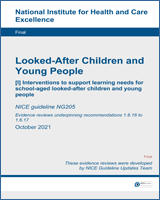From: Interventions to support learning needs for school-aged looked-after children and young people

Interventions to support learning needs for school-aged looked-after children and young people: Looked-After Children and Young People: Evidence review I.
NICE Guideline, No. 205.
London: National Institute for Health and Care Excellence (NICE); 2021 Oct.
Copyright © NICE 2021.
NCBI Bookshelf. A service of the National Library of Medicine, National Institutes of Health.